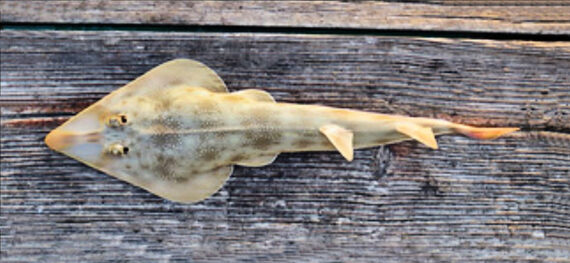Atlantic Guitarfish, Pseudobatos lentiginosus
 Atlantic Guitarfish, Pseudobatos lentiginosus. Fish caught from coastal waters off Fort Lauderdale, Florida, December 2016. Length: 97 cm (3 feet 2 inches). Catch, photograph and identification courtesy of Eli (obsessiveangling.wordpress.com).
Atlantic Guitarfish, Pseudobatos lentiginosus. Fish caught from coastal waters off Fort Lauderdale, Florida, December 2016. Length: 97 cm (3 feet 2 inches). Catch, photograph and identification courtesy of Eli (obsessiveangling.wordpress.com).
The Atlantic Guitarfish, Pseudobatos lentininosus, is a member of the Guitarfish or Rhionobatidae Family, that is also known as the Freckled Guitarfish and in Mexico guitarra diablito. There are eight global members of the genus Pseudobatos, of which seven are found in Mexican waters, two in the Atlantic and five in the Pacific Ocean.
The Atlantic Guitarfish has a heart-shaped disk with a large triangular head that tapers to a long, pointed snout with two central cartilaginous ridges, that incorporate the fused pectoral fins that has enlarged conical tubercles on the tip. The disc is longer than they are wide. The dorsal side is gray to olive brown or chocolate brown in color and is covered with small white dots that give a freckled appearance and the ventral side is pale yellow, yellowish white or plain white. The fins are slightly darker than the trunk. They have a caudal fin that lacks a lower lobe, two equal sized dorsal fins, the first of which is behind the pelvic fins, and one row of thorns along the back.
The Atlantic Guitarfish is a demersal coastal species that is found from the surface to depths up to 30 m (100 feet) over sandy substrate and weedy bottoms near patch reefs half submerged in the substrate. They are known to make seasonal migrations. They reach a maximum of 76 cm (2 feet 6 inches) in length. They feed on crustaceans and mollusks. Reproduction is ovoviparious (aplacental viviparity) with embryos feeding initially on yolk and then receiving additional nourishment via indirect absorption of uterine flue enriched with fat, protein and mucus as from their months, with 20 cm (8 inch) offsprings born live as miniature adults. Litter sized are up to six. The Atlantic Guitarfish is considered to be rare and seldom seen by humans. The Atlantic Guitarfish is poorly studied with very limited information available about their lifestyle and behavioral patterns including specific details on age, growth, longevity, movement patterns, diet, habitat use, and reproduction.
The Atlantic Guitarfish is a resident of Mexican waters of the Atlantic Ocean being found throughout the Gulf of Mexico along the coasts of Campeche, Morelos, Veracruz, Yucatán; they are absent from along the east coast of the Yucatán Peninsula within the Caribbean.
The Atlantic Guitarfish is a straight forward identification that within its range in Mexican waters cannot be confused with any other species.
From a conservation perspective the Atlantic Guitarfish is currently considered to be Near Threatened. They are prone to heavy fishing pressure and their inshore environments are subject to habitat development by humans. They are not common but caught as a by-catch of the shrimp trawl fishery and by recreational anglers. They are retained for human consumption by subsistence fishermen.